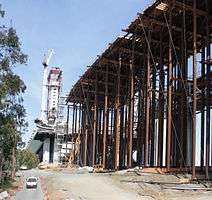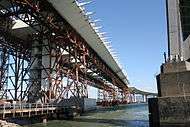Falsework

Falsework consists of temporary structures used in construction to support spanning or arched structures in order to hold the component in place until its construction is sufficiently advanced to support itself. This usage is specifically called centering. Falsework also includes temporary support structures for formwork used to mould concrete to form a desired shape,[1] scaffolding to give workers access to the structure being constructed, and shoring which is temporary structural reinforcement used during repairs.
The British Standards of practice for falsework, BS 5975:1982, defines falsework as "Any temporary structure used to support a permanent structure while it is not self-supporting."
.jpg)
History
Until the turn of the 20th century almost all falsework was constructed from timber. To compensate for timber shortages in different regions and to rationalize labor and material usage, new systems were developed.[2]
The major developments include the design of connection devices (coupler), transitions to other spanning beams such as steel pipes or profiles or reusable timber beams, and adjustable steel props. In 1935 W.A. de Vigier designed an adjustable steel prop which revolutionized many aspects of the construction industry including to support slab formwork, wall formwork, trench sheeting and falsework.[3]
During the same period many different scaffolding systems were being developed around the world. These consisted of welded frames that could be slotted or clipped together to form access or support towers. The reduction in construction time and complexity led to reduced labor costs and required less skill in assembly.
Further developments have made scaffolding systems even easier to use. Stronger systems have been introduced that either incorporate horizontal restraints (via lacers, ties, or braces) at more levels or use stronger tubes or connections. Materials from which falsework systems are manufactured have also diversified from traditional steel and timber to aluminium components.
In the UK, BS 5975 gives recommendations for the design and use of falsework on construction sites. It was first introduced by the British Standards Institute in March 1982 and was then revised in March 1996. The code is currently under revision again, a draft copy was released in late 2007, and the new version of the code is expected in the summer of 2008. The new revisions bring the code up to date with methodology developed in the new CDM 2007 regulations and also the requirements of the new European codes EN 12811-1:2003 Temporary works equipment - Part 1: Scaffolds, and EN 12812:2004, Falsework - Performance requirements and general design.
In modern roadway construction
- Fabrication
- Erection
- Placement
 Completed
Completed
Falsework
- Fabrication: Metalworkers fabricate a falsework section from pipe and beams.
- Erection: A section is lifted to a vertical position with the assistance of two forklift operators.
- Placement: The section is guided into position by a ground crew.
- Completed Falsework: Decking and some formwork has been added.
Here we see the use of modern pipe-column falsework, used to support the formwork for a post-tensioned reinforced concrete flyover connector for the eastern span replacement of the San Francisco-Oakland Bay Bridge. When the supports are complete, wood beams and plywood or reusable metal forms will be placed, reinforcing and tenon conduits added, and concrete poured. After curing and any tenon tensioning, wedges will be removed and forms and falsework disassembled.
In bridge construction

A certain type of bridge, the self-anchored suspension bridge, must be supported during construction, either by the use of cantilever or suspension methods or by support from below. Support from below was used in the construction of the main span of the eastern span replacement of the San Francisco–Oakland Bay Bridge, using parallel prefabricated truss spans
See also
- Arch bridge for the use of falsework in bridge construction.
References
| Wikimedia Commons has media related to Falsework. |
- ↑ Hardie G.M. (1995) Building Construction: Principles, Practices, and Materials. New Jersey: Prentice Hall. (Pg 116, paragraph 1) ISBN 0133505707
- ↑ Burrows B.G (198X) Thesis. (University of Warwick)
- ↑ http://www.devigier.ch/deutsch/stiftung/grunder.html